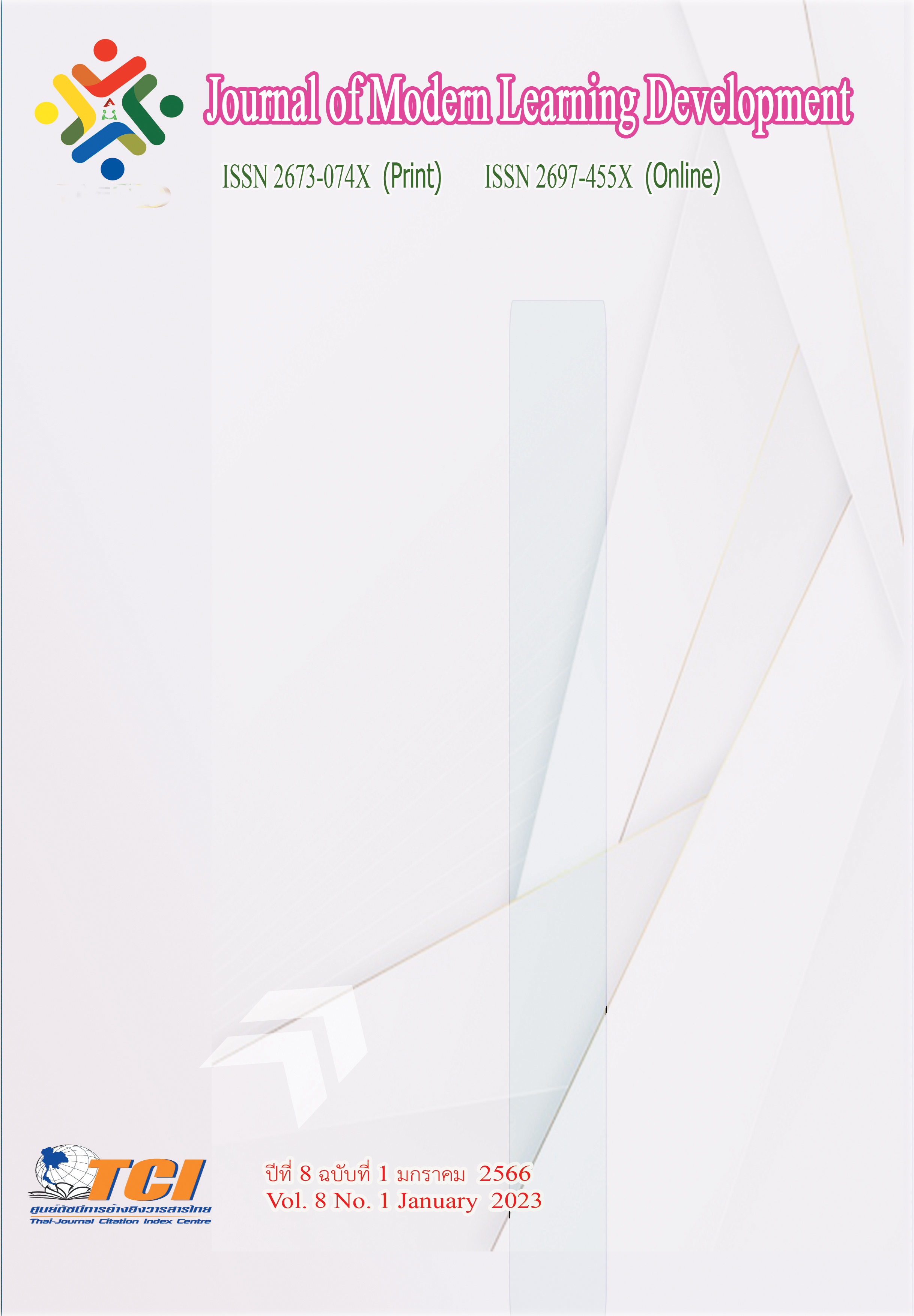The Cooperative Integrated Reading and Composition (CIRC) with Gamification Technique for Development of Spelling Abilities of Prathom Suksa 4 Students
Main Article Content
Abstract
The purposes of this research were to: 1) develop the cooperative integrated reading and composition (circ) with gamification technique for development of spelling abilities, and 2) compare spelling abilities before and after students were taught by learning the cooperative integrated reading and composition (circ) with gamification technique. The samples group of this research were 25 Prathom-suksa 4 students during first semester, 2022 academic year, at Watpratoomkanawat school. The research tools were 1) lesson plan of the cooperative integrated reading and composition (circ) with gamification, and 2) evaluation form of the writing word spelling abilities. Data analysis used in the study were mean, standard deviation, and dependent t-test. The statistical data analysis were mean, standard deviation and t-test dependent.
The results revealed that: 1.The process of the cooperative integrated reading and composition (circ) with gamification technique included 5 steps: Phase 1) Prepare, Phase 2) Teach, Phase 3) Group activities, Phase 4) Lesson summary, and Phase 5) Evaluate and awards. The lesson plan is in the excellent level ( = 4.95, S.D. = 0.21) 2. The results of the level of spelling abilities after using the cooperative integrated reading and composition (circ) with gamification technique were higher with a statistical significance at a level of .05.
Article Details
References
กมลทิพย์ ศรีนุ่ม. (2558). การพัฒนาความสามารถการเขียนสะกดคำของนักเรียนชั้นประถมศึกษาปีที่ 2 ด้วยการเรียนแบบร่วมมือเทคนิค CIRC ร่วมกับแบบฝึก. ปริญญาศึกษาศาสตรมหาบัณฑิต สาขาวิชาการสอนภาษาไทย. บัณฑิตวิทยาลัย: มหาวิทยาลัยศิลปากร.
กระทรวงศึกษาธิการ. (2551). หลักสูตรแกนกลางการศึกษาขั้นพื้นฐาน พุทธศักราช 2551. กรุงเทพมหานคร: ชุมนุมสหกรณ์การเกษตรแห่งประเทศไทย.
จีรนุช ภูทองเงิน. (2563). การพัฒนาการเขียนสะกดคำของนักเรียนชั้นประถมศึกษาปีที่ 3 โดยใช้การเรียนรู้แบบร่วมมือเทคนิค (CIRC). วิทยานิพนธ์ปริญญาครุศาสตรมหาบัณฑิต สาขาหลักสูตรและการเรียนการสอน. บัณฑิตวิทยาลัย: มหาวิทยาลัยมหาสารคาม.
ชนัตถ์ พูนเดช และ ธนิตา เลิศพรกุลรัตน์. (2559). แนวทางการจัดการเรียนรู้ด้วยแนวคิดเกมมิฟิเคชัน. วารสารศึกษาศาสตร์มหาวิทยาลัยนเรศวร. 18 (3), 331-339.
นภาเพ็ญ แสนสามารถ. (2562). การพัฒนาแบบฝึกทักษะวิชาภาษาไทย โดยใช้การเรียนแบบร่วมมือเทคนิค CIRC ร่วมกับการอ่านการเขียนแบบแจกลูกสะกดคำ เพื่อเสริมสร้างทักษะการอ่านและการเขียน การคิด วิเคราะห์ และผลสัมฤทธิ์ทางการเรียนของนักเรียนชั้นประถมศึกษาปีที่ 1. วิทยานิพนธ์ปริญญาครุศาสตรมหาบัณฑิต สาขาวิชาการวิจัยและพัฒนาการศึกษา. บัณฑิตวิทยาลัย: มหาวิทยาลัยราชภัฏสกลนคร.
มะลิวัลย์ พรนิคม. (2559). การพัฒนาชุดกิจกรรมการเรียนรู้การอ่านวรรณคดีไทย โดยใช้เทคนิค CIRC สําหรับ นักเรียนชั้นมัธยมศึกษาปีที่ 4. วิทยานิพนธ์ปริญญาศึกษาศาสตรมหาบัณฑิต สาขาวิชาหลักสูตรและการสอน. บัณฑิตวิทยาลัย: มหาวิทยาลัยบูรพา.
วิชิระ อุดมรัตน์. (2560). การส่งเสริมพฤติกรรมการทำงานกลุ่มโดยการจัดกิจกรรมการเรียนรู้แบบกลุ่มร่วมมือแข่งขันร่วมกับเทคนิคเกมมิฟิเคชันสำหรับนักเรียน. วิทยานิพนธ์ปริญญาครุศาสตรมหาบัณฑิต สาขาคอมพิวเตอร์ศึกษา. บัณฑิตวิทยาลัย: มหาวิทยาลัยราชภัฎมหาสารคาม.
สำนักงานเลขาธิการสภาการศึกษา. (2564). คู่มือ การนำกรอบสมรรถนะหลักของผู้เรียนระดับประถมศึกษาปีที่ 4 - 6 ไปใช้ในการพัฒนาผู้เรียน. กรุงเทพมหานคร: บริษัท พริกหวานกราฟฟิค จำกัด.
Kapp, K. M. (2012). The gamification of learning and instruction: Game-based methods and strategies for training and education. San Francisco: CA L Pfeiffer.


